Supercat Fast Ferry Corporation
 | |
| Private company | |
| Industry | Ferry Services |
| Founded | Aboitiz(1994) |
| Headquarters | Supercat Terminal Pier 4, North Reclamation Area, Cebu City, Philippines |
| Website | http://www.supercat.com.ph/ |
The SuperCat Fast Ferry Corporation, commonly known as SuperCat was a shipping company that operated a fleet of High Speed Catamarans (HSC) in the Philippines. It is now part of 2GO Travel, subsidiary brand of the 2GO Group.[1] Supercat was the sister company of SuperFerry and Cebu Ferries. Supercat operated 7 vessels in 7 ports around the Philippines.
Brief history
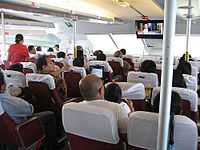
Batangas - Calapan route is one of the most important shipping routes in the Philippines. During the early 1990s, the route was dominated by a single large shipping company. Travelling during those days could take up to 3 hours and be uncomfortable. In 1994, Rodolfo G. Valencia, former governor of Oriental Mindoro, invited the Aboitiz group to ply the route. His intention was to bring a more convenient alternative to Mindoro. Under the management of Universal Aboitiz Inc., M/V Supercat 1, their pioneer vessel, traveled between Batangas and Calapan in only 45 minutes.
Supercat added routes throughout the Visayas Region. Fast craft became popular in the Philippines. In 1997, Sea Angels (owned by Negros Navigation) merged with Aboitiz Equity Ventures and Hong Kong Park View Holdings to form the Supercat Fast Ferry Corporation.[2] Supercat also acquired 2 vessels from Waterjet Shipping Corporation (owned by Waterjet Netherlands Antilles). They renamed it as Supercat 17 (former Waterjet 1, currently FastCat Ryde) and Supercat 18 (former Waterjet 2, currently FastCat Shanklin).[3] The merger was eventually dissolved in 2002 and SuperCat became solely owned by Aboitiz. The abolition of the WG&A merger then soon unraveled. Supercat sacrificed some of its vessels and their corresponding routes in order to sustain its fast craft operations. Supercat also downsized from 200 to just 100 employees.[2]
From the 1990s to early 2000s, all Supercat vessels were jet-powered. Due to economic problems, Aboitiz was forced sell ships reducing an original fleet of fourteen down to just seven.[2][4]
To cope with the soaring fuel prices, Supercat started replacing their previous fleet with more fuel-efficient vessels. At present, all jet-powered Supercat HSC vessels were replaced by more fuel efficient vessels using a simple propulsion system.[5]
Destinations [6]
Current Destinations


- Batangas City, Batangas
- Bacolod City, Negros Occidental
- Calapan City, Oriental Mindoro
- Cebu City, Cebu
- Iloilo City, Iloilo
Active Routes [6]
- Batangas - Calapan v v. (1 hour 10 minutes)
- Cebu - Ormoc v v. (2 hours and 20 minutes)
- Cebu - Tagbilaran v v. (1 hour 45 minutes)
- Iloilo - Bacolod v v. (1 hour 15 minutes)
Fleet
The Supercat fleet was mainly composed of high-speed catamarans, but they also owned monohulled vessels.[7]






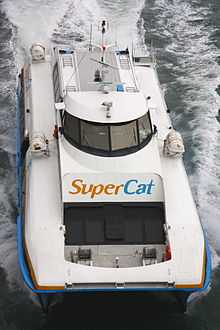
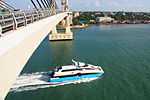
Vessels
St. Nuriel (formerly Supercat 22)
St. Nuriel is formerly SuperCat 22 M/V Mt. Samat Ferry 3, which was operated by defunct Philippine fast ferry company, Mt. Samat. The Supercat 22 was built by FBMA Marine Inc. (an Aboitiz Company) in Balamban, Cebu. This vessel uses a simple propulsion system, and is very fuel efficient. In July 2010, she was added a second deck. She is currently serving the Batangas - Calapan route.
St. Uriel (formerly SuperCat 23)
St. Uriel was the only high speed monohull vessel in the Supercat fleet. She uses a simple propulsion system and her fuel is efficient. She also offers an open deck accommodation at a more affordable price. She is currently in Cebu awaiting her fate after news that she was sold.
St. Sealthiel (formerly SuperCat 25)
St. Sealthiel was formerly SuperCat 25 & M/V Mt. Samat Ferry 5, which was operated by defunct Philippine fast ferry company, Mt. Samat. She is a sister ship of Supercat 22 and was also built by FBMA Marine Inc. (an Aboitiz Company) in Balamban, Cebu. Similarly this vessel uses a simple propulsion system, and is very fuel efficient. She was renamed as M/V Smart in Korea, before ending up with Supercat Fast Ferry Corp. She is currently serving the Batangas - Calapan route.
SuperCat 26
SuperCat 26 was the former SeaCat from Australia, traveling Perth to Rottnest Island. She has twin Caterpillar C32 engines and can cruise up to 28 knots. She's 25m in length. She is currently serving the Bacolod-Iloilo route in the Western Visayas region of the Philippines.
St. Jhudiel (formerly SuperCat 30)
St. Jhudiel was formerly SuperCat 30 & formerly one of Elbe City Jet's catamaran. She was named Hanseblitz from 1996–2001 and was reconfigured and elevated its Captain's bridge at Abeking & Rasmussen, and later on acquired by Transtejo in Lisboa,Portugal renamed Bairro Alto until early 2008. She has two decks. The upper deck offers business class accommodation for elite passengers. This vessel was built by Lindstol Skips, in Risor Norway. Unlike the other Supercat vessels, this vessel is equipped with controllable pitch propellers as its propulsion system. Supercat 32 is her sister ship. She is currently serving the Cebu - Tagbilaran route.
St. Braquiel (formerly SuperCat 32)
St. Braquiel was formerly SuperCat 32 & formerly one of Elbe City Jet's catamaran. She was named Hansepfeil from 1996–2002 and was reconfigured and elevated its Captain's bridge at Abeking & Rasmussen, and later on acquired by Transtejo in Lisboa,Portugal renamed Parque das Nacoes until early 2008. She has two decks. The upper deck offers business class accommodation for elite passengers. This vessel was built by Lindstol Skips, in Risor Norway. Unlike the other Supercat vessels, this vessel is equipped with controllable pitch propellers as its propulsion system. Supercat 30 is her sister ship. She is currently serving the Cebu-Ormoc route.
St. Benedict (formerly SuperCat 36)
St. Benedict, formerly known as SuperCat 36 and Blue Fin, is one of three Sydney JetCats purchased in 1990 for the Manly service to replace hydrofoils. She operated from Manly to Circular Quay from 1990 until 2008 before being sold to Supercat.[9][10] She uses a KAMEWA waterjet-propulsion and her maximum service speed can reach up to 31 knots.[11]
St. Dominic (formerly SuperCat 38)

St. Dominic, formerly known as SuperCat 38 and Sir David Martin, is one of three Sydney JetCats purchased for the Manly service to replace hydrofoils. She operated from Manly to Circular Quay from 1990 until 2008 before being sold to Supercat.[9] She uses a KAMEWA waterjet-propulsion and her maximum service speed can reach up to 31 knots.[11]
Former Vessels
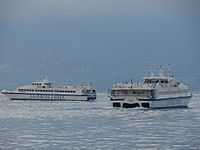
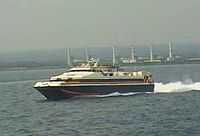
- Supercat 1 (sank-off en route to Calapan City, Mindoro)
- Supercat - I (sold to Emeraude Lines renamed as NORMANDIE EXPRESS, later renamed as Moorea Express)[12]
- Supercat 2 (sold to Korean Shipping Company KOREA EXPRESS FERRY CO.,Ltd, renamed as Korea Express)
- Supercat 3 (sold to Croatian Shipping Company Jadrolinija, renamed as Karolina [13])
- Supercat 5 (sold to Croatian Shipping Company Jadrolinija, renamed as Judita[13])
- Supercat 6 (sold to Moreton Bay Whale Watching, sold to Seo Kyung Korea renamed as Gold Coast)
- Supercat 7 (sold to Croatian Shipping Company Jadrolinija, renamed as Novalja[13])
- Supercat 8 (sold to Croatian Shipping Company Jadrolinija, renamed as Dubravka[13])
- Supercat 9 (sold to Croatian Shipping Company, renamed as Bisovo)
- Supercat 10 (sold to Korean Shipping Company WONDERFUL ISLAND CO., renamed as Mosulpo 1 (모슬포1호))
- Supercat 11: St. Raphael (sold to Italian Shipping Company Ustica Lines, renamed as Federica M)
- Supercat 12: St. Gabriel (sold to Italian Shipping Company Ustica Lines, renamed as Gabrielle M)
- Supercat 17 (sold to Wightlink for use between Portsmouth and Ryde,[14] Renamed as FastCat-Ryde)
- Supercat 18 (sold to Wightlink for use between Portsmouth and Ryde,[15] Renamed as FastCat-Shanklin )
- Supercat 20 (sold to South African Shipping Company FakoShip, renamed as Endurance)
- Supercat 21 (returned to her lessor [5])
- Supercat 2001/Tricat 50 (sold, renamed as SEA POWER 1)
- Supercat 2002 (sold to a Dutch Shipping Company, renamed as Tiger)
Trivia



- Sometime in 1994, M/V Supercat sank off near Calapan City. There were no casualties. All passengers were rescued by another RORO vessel. There were speculations that the vessel was sabotaged. It was not proven though.
- Supercat 6 was the smallest Supercat vessel
- In commemoration of the Philippine Independence Centennial, Supercat repainted some of its vessels with a "Philippine Flag Livery".
- TriCat 50 was renamed as Supercat 2001.
- Supercat had already owned three (3) mono hull fast crafts (namely SC 20, 21 & 23) in its history.
- The brand "Supercat" was derived from two words, "SUPER" and "CATamaran"
- Sharon Cuneta filmed Supercat's TV Ad in both Batangas City and Calapan City. The Ad was only advertised on board and through local cable networks TV Ad in Roxas, Oriental Mindoro and Iloilo City.
- Supercat used to have its own exclusive terminal in Calapan. The terminal was eventually demolished after a bigger and better public terminal was constructed in 2009.
- Supercat was sued for mandating an additional terminal fee on top of the fare in Calapan, for use of their newly constructed exclusive terminal. Supercat was then forced to remove the terminal fee.
- The Catamaran Judita, formerly Supercat 5, is now labeled as the "Pope's Catamaran". Pope John Paul II rode Judita from Omišalj to Rijeka in his visit to Croatia
See also
- SuperFerry
- Montenegro Lines
- Cebu Ferries
- Negros Navigation
- Roble Shipping Inc.
- List of shipping companies in the Philippines
References
- ↑ SuperCat - SuperFerry Travel and Leisure - About Us
- ↑ 2.0 2.1 2.2 An assessment of Year One of the Aquino administration (30 June 2011), philippinebusiness.com.ph (archiveed from the original on 2011-07-22).
- ↑ Wightlink Ferry Postcards & Photographs
- ↑ SuperCat attacks Philippine ferry standards (May 1, 2005), allbusiness.com (archived from the original on 2008-03-19),
- ↑ 5.0 5.1 SuperCat buys new vessel for $1.7M (October 17, 2007), supercat.com.ph. (archived from the original on 2009-03-19).
- ↑ 6.0 6.1 SuperCat - SuperFerry Travel and Leisure - Destinations
- ↑ SuperCat - SuperFerry Travel and Leisure - Our Fleet
- ↑ Supercat 22 Safety Video - YouTube
- ↑ 9.0 9.1 Manly Jet Cat Sea Eagle living in Kazakstan Yacht & Boat 29 June 2011
- ↑ Blue Fin / SuperCat 36 Ferries of Sydney
- ↑ 11.0 11.1 Jet Car Withdrawal and Manly Fast Ferry Commencement NSW Ministry of Transport
- ↑ http://archive.is/20120905224448/http://www.faktaomfartyg.nu/oregrund_1988.htm
- ↑ 13.0 13.1 13.2 13.3 Jadrolinija - Page 6: Fast Ferries
- ↑ FastCat-Ryde - Wightlink - Ferry Postcards & Photographs
- ↑ Wightlink Ferry Postcards & Photographs